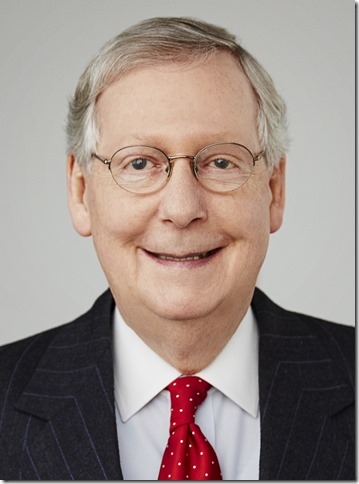While prominent voices like those of David Frum of The Atlantic , Jim Geraghty of National Review and Peggy Noonan of the Wall Street Journal have all called for a swift second impeachment of President Trump for instigating the mob that sacked the U. S. Capitol building in their attempt to stop the Constitutionally mandated counting of the electoral vote, this process appears to have been slowed down by Mitch McConnell’s January 8 memo stating that the Senate cannot begin to act on any impeachment articles from the House until January 19th at the soonest, one day before Joe Biden’s inauguration.
McConnell is misleading and pulling a combination of what he did to Merrick Garland by using parliamentary procedure to not act with Bill Barr’s traducing of his friend Robert Mueller by misrepresenting the actual case before him.
McConnell has a reputation as a master of Senate parliamentary procedure, and has used this reputation to hoodwink the public and his fellow Senators. There are in fact multiple ways to begin Senate impeachment hearings before January 19th.
The Senate is currently adjourned for three day increments and holding pro forma sessions in between. According to Mitch McConnell’s memo,
“It would require the consent of all 100 senators to conduct any business of any kind during the scheduled pro forma sessions prior to January 19, and therefore the consent of all 100 senators to begin acting on any articles of impeachment during those sessions.”
According to a report Mitch McConnell had drawn up by the Congressional Research Service in 2012 about pro forma sessions, however, the correct language is not the consent of all 100 senators but rather unanimous consent, which is a very different thing that pretends to be the same thing. In fact the House just tried to pass a resolution by unanimous consent earlier today to request that Vice President Mike Pence invoke the 25th Amendment, and it basically means that unless anyone voices an objection we’ll all just pretend that all members agreed. (Someone did object, by the way, and the vote will be tabled for tomorrow.)
The CRS also, in this report, identifies two pro forma sessions of the Senate in which legislative business occurred through unanimous consent, on December 23, 2011 and August 5, 2011.
The report also states that there two ways to conduct business during a pro forma session and not just the one that McConnell claims in his recent memo:
“While, as noted above, the Senate has customarily agreed not to conduct business during pro forma sessions, no rule or constitutional provision imposes this restriction. Should the Senate choose to conduct legislative or executive business at a pro forma session, it could, providing it could assemble the necessary quorum or gain the consent of all Senators to act.”
So what are pro forma sessions and why is a) unanimous consent different from the b) consent of 100 senators. Also, why does McConnell think he can get away with conflating these two things?
Pro forma sessions are effectively sessions that last under five minutes in the Senate during which nothing is accomplished but which must be held in order to be in compliance with Article 1, Section 5, Clause 4 of the Constitution.
Neither House, during the Session of Congress, shall, without the Consent of the other, adjourn for more than three days, nor to any other Place than that in which the two Houses shall be sitting.
By holding a pro forma only meeting every three or so Congressional business days, either chamber can take an extended adjournment, allowing members the time to visit constituents, raise money, and so on, without technically violating the Constitution or requiring the consent of the other chamber.
In 2012, President Obama challenged the status of the pro forma session when it was being used by Mitch McConnell to block the President’s recess appointments. His administration claimed that these were not real sessions and that therefore the Congress was effectively in recess.
The Supreme Court disagreed in their decision in National Labor Relations Board v. Noel Canning, stating that pro forma sessions are not just for show because 1) the Senate says they aren’t and also because 2) legislative action can occur by unanimous consent because a quorum, required for unanimous consent, is presumed, even if it doesn’t exist actually.
Confusing, isn’t it? I’ll quote extensively from this analysis from the Tom Goldstein of SCOTUSblog, which elucidates the matter further:
The interesting point is that (b) is rests on a fiction: there actually is no Senate quorum during a pro forma session. As Mitch McConnell’s brief in the Supreme Court explains, “The Senate, in other words, has provided that a quorum is presumed until proven otherwise.” And it is a fiction the Court definitively accepts: “[W]hen the Journal of the Senate indicates that a quorum was present, under a valid Senate rule, . . . we will not consider an argument that a quorum was not, in fact, present.”
Yet that critical presumption that a quorum exists is easily burst: any member of the Senate can suggest the absence of a quorum. “During any pro forma session, the Senate could have conducted business simply by passing a unanimous consent agreement. . . . Senate rules presume that quorum is present unless a present Senator questions it.” As Noel Canning’s brief in the Supreme Court explains, “whenever the Senate lacks quorum . . . , a single Senator can prevent the Senate from conducting business by making a quorum call.”
It’s turtles all the way down. To recapitulate:
- A pro forma session counts as a real session, for Constitutional purposes, if legislative action can occur during this session.
- Legislative action can occur during a pro forma session through unanimous consent.
- Unanimous consent requires a quorum comprised of a simple majority of all senators (51).
- Even if a quorum is not actually present, the rules of the Senate maintain the fiction that one is unless a senator calls for a quorum count.

So what would happen if a senator entered the senate chamber and requested a quorum count? Presumably something like this:
- It would be discovered that there is not a quorum.
- Without a quorum, no business can be done.
- If no business can be done, the the Senate is in violation of the Constitution Article 1, Section 5, Clause 4.
- The Senate must call on the Sergeant-at-arms to wrangle up 51 senators, so there is a quorum, so legislative action can occur in compliance with the Supreme Court’s decision in National Labor Relations Board v. Noel Canning.
Supposing there are 48 Democratic senators and at least 3 Republican senators willing to be in the Capitol Building to receive and act on Impeachment Articles from the House, this can happen as early as tomorrow. The next opportunity will be on January 15th at the next pro forma session of the United States Senate.
And thus Mitch McConnell’s attempt to obstruct congress can be toppled, by the numbers. Turtles all the way down.


[…] of who should preside over the second impeachment trial of President Donald Trump. This is the second time of late that I’ve opined on matters for which I am fairly unqualified to opine. I’m even […]